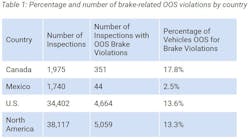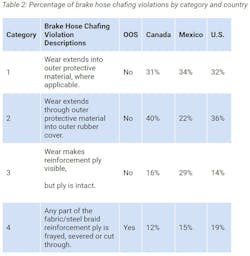Brake Safety Week inspectors place 13.3% of vehicles out of service
Inspectors placed 13.3% of the commercial vehicles they examined out of service during Brake Safety Week in August as 38,117 inspections were conducted during the brake-related event in the U.S., Canada, and Mexico, according to a release from the Commercial Vehicle Safety Alliance.
As part of CVSA’s Operation Airbrake program in partnership with the Federal Motor Carrier Safety Administration in the U.S., Canada’s Council of Motor Transport Administrators, and Mexico’s Ministry of Communications and Transportation, 87% of the August safety inspections did not yield any brake-related violations, according to CVSA.
The inspections conducted during Brake Safety Week are no different from those conducted any other day of the year. During the week, however, inspectors compiled and then submitted brake-related data to CVSA for compilation, analysis, and release.
Broken out by country, inspectors in Canada examined 1,975 commercial vehicles and placed 351 (17.8%) out of service for brake-related violations. In Mexico, 1,740 were inspected. Of those, 44, or 2.5%, were placed out of service. In the U.S., of the 34,402 vehicles inspected, 4,664 (13.6%) were placed out of service.
In addition, 11 jurisdictions with performance-based brake testers (PBBT) assessed the braking performance of 392 commercial vehicles during Brake Safety Week. Of those assessed, 29 vehicles failed PBBT tests, a 7% out-of-service rate. PBBTs, based on mechanical or electronic decelerometers, assess a vehicle’s braking capability through a stopping performance test in which deceleration and/or stopping distance is obtained, independent of brake type or application method.
During Brake Safety Week, inspectors primarily conducted the standard North American Level I or Level V inspections. Both levels include examination of brake systems and components. Inspectors look for missing, non-functioning, loose, cracked or broken parts, such as spider castings, return springs, brake drums or rotors, brake shoes, linings or pads, and slack adjusters.
They also look for contaminated linings or pads, non-manufactured holes in spring-brake housings, S-cam flip-over, and audible air leaks. They check for mismatched brake chambers on an axle, security of air reservoirs, condition of hoses and lines, air pressure in the system, the breakaway device, tractor protection system, pushrod travel, and brake-system warning devices.
CVSA is a nonprofit organization made up of local, state, provincial, territorial, and federal commercial motor vehicle safety officials and industry representatives. The alliance aims to prevent commercial vehicle crashes, injuries, and fatalities and believes that collaboration between government and industry improves road safety and saves lives.
In June, CVSA announced this year’s Brake Safety Week dates. It announces these dates in advance to remind drivers and motor carriers about the importance of proper brake maintenance and to encourage proactive vehicle maintenance in advance of the special inspection campaign, according to the Nov. 15 CVSA release. Next year’s Brake Safety Week is scheduled for Aug. 20-26.
The goal of the special inspection campaign is to reduce the number of crashes caused by faulty braking systems by conducting roadside inspections and educating drivers, mechanics, and owner-operators on the importance of proper brake inspection, maintenance, and operation.
In June, inspectors examined 6,204 vehicles transporting hazardous materials or dangerous goods and 6,668 packages in the U.S. and Canada during an unannounced five-day enforcement initiative for CVSA.
Held June 13-17, inspectors during the Hazardous Materials/Dangerous Goods Road Blitz found 1,774 hazardous materials/dangerous goods violations. Vehicles issued hazardous- or dangerous-related out-of-service violations—or any other driver or vehicle out-of-service violations—were restricted from traveling until all out-of-service violations were addressed.
CVSA’s annual International Roadcheck in May focused on wheel ends but found that bad brakes and false driver logs were the most common 2022 violations. Roadside inspectors put more than 12,000 commercial vehicles and nearly 4,000 drivers out of service during Roadcheck. CVSA-certified inspectors conducted about 59,000 inspections during the May 17-19 blitz.
This article originally appeared on FleetOwner.


